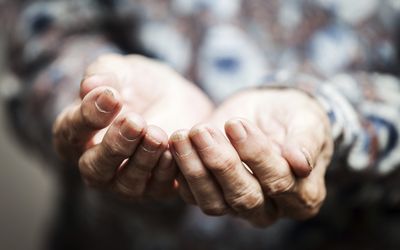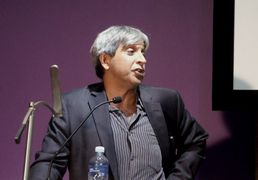THIS year will be remembered as the one when the "born frees" took centre stage, standing up and making their voices heard after what seemed like years of political silence.
Nearly half of the born frees did not even register to vote in last year’s elections, compared with about 90% of the older generation. But this year, at least some of them announced their presence, denouncing the symbols of the old oppressive regime and challenging the high levels of poverty and inequality that have persisted in the post-apartheid era.
Young people under 25 make up nearly half of the country’s population. They had not yet been born when Nelson Mandela walked free after 27 years in prison. They were toddlers when South Africans stood in snaking lines to cast their vote in the first democratic elections in 1994. And by the time president Mandela left office, most were in primary school.
Their parents may have voted for freedom in 1994, but many have still to realise the promise of a better future. More than half of SA’s youth continue to live in income poverty, defined as living in a household with a monthly income of less than R620 per person, the so-called "upper-bound poverty line". Youth poverty levels remain strikingly similar to those of their parents’ generation, and income poverty continues to be strongly associated with race: Sixty-five percent of African youth live below this poverty line, compared with just more than 4% of white youth, suggesting that postapartheid policies have not yet levelled the playing field.
Many experience deprivation in several areas of their lives at the same time: those who live in households with high unemployment are also likely to be those with low levels of education, poor health and limited access to housing and basic services.
If SA is to deliver on promises of equal opportunities and better lives for all, it needs an assertive policy focus on young people. Otherwise we will fail not only this generation, but also the next cohort of children, who will be parented by today’s youth.
This week, the University of Cape Town’s Children’s Institute and several organisations committed to finding effective policies against poverty and inequality, including the university’s Poverty and Inequality Initiative, launch the South African Child Gauge 2015, an annual publication that tracks the status of youth and children. We hope it will extend a necessary conversation about effective policies to halt the trajectory of deprivation and to create pathways that will enable young people to fulfil their dreams.
The widespread student protests against increased university fees were a clear expression of disillusionment and anger with the current state of affairs. For too long, youth have been clear about their hopes and dreams for a more equitable SA. Thirteen years ago, the 2002 Cape Area Panel Study asked 5,000 young people about their educational aspirations. More than 60% (aged 14 to 22) said they expected to complete some form of higher education. Expectations were especially high among African youth from poorer backgrounds. Research shows that young people aspire to the kinds of successful careers enjoyed by middle-and upper-class (often white) households, and that education is seen as an important path to reach that goal.
But, sadly, these aspirations are in stark contrast to the reality that many young people find themselves in. While young people today have higher levels of education than their parents, their educational outcomes remain low and have not translated into better job opportunities. Studies show that less than half the cohort of children who entered Grade one in 2002 actually wrote the matric exams 12 years later. Only 14% of the original cohort passed with a university exemption, and current trends indicate that only half of those who enrol at a university will eventually graduate.
The reality is that learning outcomes for poor children are consistently lower than those of the more wealthy, and not because of a lack of ability or effort. For those who drop out, there is little remedial action to push them back into the educational system. Take the situation of Siya, for instance, a young man from Gugulethu, interviewed in a research project a few years ago.
Siya was 21 at the time. He worked some odd jobs, but his main source of income was his grandmother’s pension. His parents had died — his mother from illness, and his father shot dead in Gugulethu in 2003 "over nothing … he died for nothing".
Siya was studying engineering at Cape Technikon at the time of his father’s murder. His father had been paying his fees, but suddenly his future stopped in its tracks. He applied for bursaries and loans, but was unsuccessful and could not continue his studies. This was an enormous blow.
"When I was six, I had this dream of driving a car and living in my own flat. I am now 21. People of my age have cars and live in their own space, they are not staying with grandmothers. Those are the sort of things that stress me." Nonetheless, he described himself as a "go-getter", and persisted. He found several odd jobs, as well as funding for short courses at the Technikon. But when we spoke to him, his grandmother had become ill and moved back to the Eastern Cape, and he felt he no longer had a real home from which to study. He was concerned he would not make it through the exams at the end of the year.
As a result of the low educational outcomes, and compounded by the structure of the labour market and sluggish growth of the South African economy, youth unemployment is high. The lack of earning capacity in turn influences nutrition and physical and emotional wellbeing. Health can affect educational outcomes, and so the cycle of deprivation perpetuates itself.
This is not to say nothing has changed. During the postapartheid period, the dramatic rise in the number of social grant recipients — 2.4-million in 1998 to 16-million in 2011 — has provided crucial income support to poor households. The National Income Dynamics Survey shows that job searches among young people increase in households that get old-age pensions, and that access to social grants helps mitigate the intergenerational transmission of mental health problems such as depression.
However, the public transfers of resources through grants alone are not sufficient to break the cycle: in the case of education, for example, expenses include not only fees but also the cost of books, transport, uniforms and extracurricular activities. The quality of education matters too as it influences the levels of knowledge and skills that youth need to access either higher education or the labour market.
Good education is a key element in breaking the cycle of poverty before it is passed on to the next generation. There are other interventions too that need to be explored. The time to put young people at the centre of our policies for development has never been more urgent.
• De Lannoy is the lead editor of the South African Child Gauge 2015. Green is a journalist who worked on the project























Change: 1.19%
Change: 1.36%
Change: 2.19%
Change: 1.49%
Change: -0.77%
Data supplied by Profile Data
Change: -0.08%
Change: 0.12%
Change: 1.19%
Change: 0.00%
Change: 0.10%
Data supplied by Profile Data
Change: 0.32%
Change: 0.40%
Change: 0.40%
Change: 0.22%
Change: 0.58%
Data supplied by Profile Data
Change: 0.09%
Change: -0.41%
Change: -0.13%
Change: -0.33%
Change: 0.10%
Data supplied by Profile Data